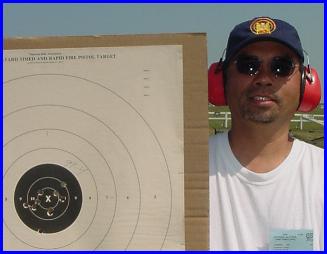
Greetings Shooting Colleagues,
Having difficulties seeing the front sights and experiencing dry eyes seem to be common problems of shooters with advancing age. There have been discussions about blinking one's eyes prior to shooting a sustained fire string and the use of Visine. The reason for this is to provide a smooth tear film over the cornea for best vision, even if for only a moment. This would not replace the need for prescription shooting lenses, if vision is uncorrected.
Assuming vision is the very best possible, we may then need to draw our attention to our precious tear film. The tear film consists of three layers, the mucin, the aqueous, and the lipid. The outer lipid layer prevents tear evaporation, which is very important. As eye specialists, we can actually count the number of seconds before we note the evaporation of the tear film, following each blink. Ten seconds and longer is considered normal. With each blink, a fresh tear film covers the eye again. Some eyes may start to dry up as early as two seconds.
Aging, use of antihistamines or other medications, wearing of contact lenses, Lasik surgery, computer use, and dry environmental conditions may all contribute to the symptoms of dry eyes. Dry eyes may be caused by rapid evaporation and/or decreased tear production.
Antihistamine eye drops are not recommended for simple lubrication purposes. Why "Get the Red Out" when the only problem is the lack of tears. Dry eyes tend to be a chronic condition, with drops providing only temporary relief. Thicker, more viscous drops or gels are generally recommended before going to sleep. Shooters would not want to use this type of drop just before or during a match. The thinner and more aqueous drops are best for shooters while at the line, regardless for seeing the open sights or the red dot.
One of my favorite lubricants was developed by a contact lens innovator, Donald Korb. It is called Soothe XP from Bausch and Lomb. It not only replenishes moisture but aids the lipid layer from tear evaporation. A whitish film is noted after instillation which may take a couple of minutes to clear up. This lubricant may not be suitable immediately before shooting. Soothe is also available in preservative free single use tubes which do not leave this initial white film.
Another effective lubricant I use is MiniDrops Eye Therapy from Optics Laboratory. These are preservative free which eliminates possible sensitivity to the preservative. They are packaged in single use droppers which are convenient for those who need lubrication from time to time. All tubes are sealed until needed, avoiding contamination. This drop does not cause the white film when instilled and is also suitable for contact lens re-lubrication. These single use tubes are ideal to be included in any gunbox for emergencies when debris enters the eye while at the firing line. Eye-Cept, from the same manufacturer, is available specifically for soft contact lens wearers.
Some of you crusty old shooters may think I have stock in these companies. :-) I do not. I've only mentioned four different lubricants but you will find dozens on the drug store shelves, with many brands containing the same or similar ingredients. Lubricants are safe for continued daily use.
A word about eye allergies while shooting. I experience this during the Spring seasons as many of you do. Excessive tearing affects our sighting, but antihistamines may affect our sighting also. My worst experience was at Camp Pendleton during a California state match in the Spring with winds not unlike Camp Perry. I have yet to find a suitable solution for myself, except for going back to trigger control. Trying to suppress a sneeze while the eyes are watery during rapid fire is a challenge.
Good Vision and Good Shooting to All,
Norman H. Wong, O.D.
